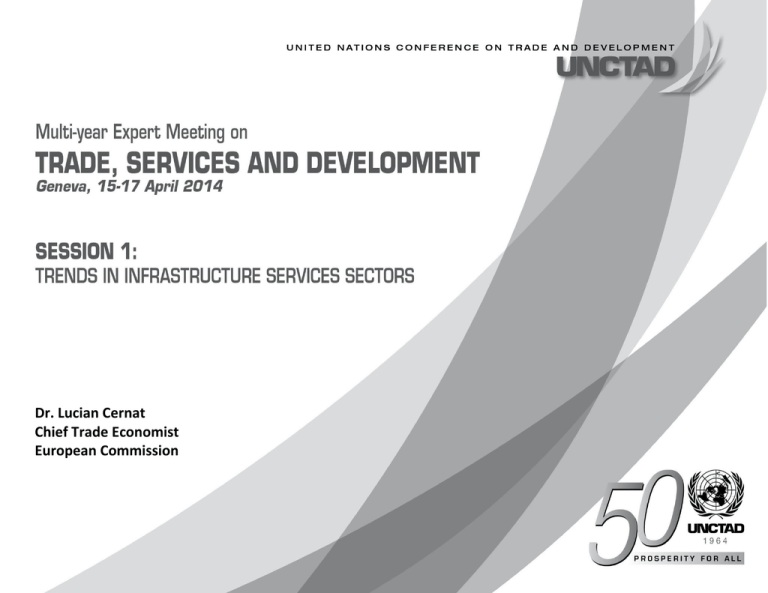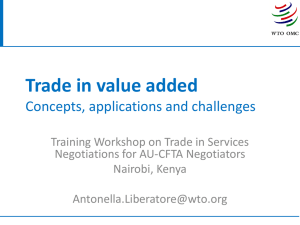Dr. Lucian Cernat Chief Trade Economist European Commission
advertisement

Dr. Lucian Cernat Chief Trade Economist European Commission Trade in services: European and global issues Dr. Lucian Cernat Chief Trade Economist European Commission @Lucian_Cernat 1 Key points • The role of services in competitiveness – Value added, job creation and productivity • Beyond GATS modes of supply: – Mode 5 "services in boxes" exports • Comparative advantages – The role of education • Barriers to services trade – Some policy priorities 2 The role of services in competitiveness 3 EU trade in services: stats at first sight EU‐27 trade in services (extra‐EU) 100% goods 80% 73% 78% 60% 40% services 20% 27% 22% Exp Imp 0% 4 The EU Single Market : the relevance of services Added value at basic prices by economic activity, 2010 (NACE Rev.2) Employment by economic activity, 2010 (NACE Rev.2) 75.8% 80% 80% 71.0% 60% 60% 40% 40% 14.9% 20% 15.7% 20% 5.5% 2.3% 0% 0% Agriculture (sections A end B) Manifacturing (section C ) Services (sections from D to T excluding O ‐ PA) shares of total empl (age 15‐74) Agriculture (sections A end B) Manifacturing (section C )* Services (sections from D to T excluding O)* Shares of total added value Notes: Totals also include O84 (Public Admin and defence), U99 and NRP; Source: LFS and Eurostat ‐ National Accounts 5 Shares of total employment 0% shares of total added value T ‐ Activities of households as employers; 3.0% S ‐ Other service activities 6.9% R ‐ Arts, entertainment and recreation 3.2% 4.9% Q ‐ Human health and social work activities 1.6% 2.4% 1.2% 6.4% P ‐ Education 5.1% 4.4% O ‐ Public administration and defence; compulsory social security 10% J‐N Business services 7.4% I ‐ Accommodation and food service activities 10.3% H ‐ Transportation and storage 20% G ‐ Wholesale and retail trade; repair of motor vehicles and motorcycles Employment, 2010, shares F ‐ Construction 30% D‐E ‐ Utilities T ‐ Activities of households as employers S ‐ Other service activities 1.5% R ‐ Arts, entertainment and recreation Q ‐ Human health and social work activities 7.7% P ‐ Education 14.1% J‐N ‐ Business services I ‐ Accommodation and food service activities H ‐ Transportation and storage G ‐ Wholesale and retail trade; repair of motor vehicles and motorcycles 10% F ‐ Construction D‐E ‐ Utilities Within services industries: business services stand out Added value (basic prices), 2010, shares 30% 30.7% 20% 14.9% 11.2% 5.2% 7.4% 1.3% 1.7% 0.5% 0% 6 sh of total export 982 ‐ Services not allocated 291 ‐ Government services, n.i.e. 287 ‐ Personal, cultural and recreational services Business Services (approx) 249 ‐ Construction services 245 ‐ Communications services 236 ‐ Travel 205 ‐ Transportation Business services is big business EU‐27 services trade (share of total trade) ,2011 by EBOPS groups 16.0% 14.0% 12.0% 10.0% 8.0% 6.0% 4.0% 2.0% 0.0% sh of total import 7 Comparative advantages vary: countries need each other Net trade in labour by educational categories, (2009) 200 150 50 ‐150 High Medium Germany Poland United Kingdom France Portugal Belgium Spain Netherlands Italy Japan Canada Russia South Korea ‐100 Brazil ‐50 United States 0 China bn US‐$ 100 Low source "Value Added and Factors in Trade: A Comprehensive Approach" Robert Stehrer, Neil Foster, Gaaitzen de Vries (2012) WIOD Working Paper no. 7 8 The EU Single Market: key lessons • 1993 to 2003 – a decade of integration progress – Over 2.5 million extra jobs – nearly € 900 billion additional economic benefits – about € 6000 per family in the EU • Unique integration experience among a large number of countries – Automatic recognition of professional qualifications • Single Market is great but not complete! – E.g. roaming charges, energy, etc. 9 Canada: is grey matter the new commodity boom? Comparison of International Education Services with Other Top Exports in Goods from Canada Selected countries , 2008 10 Beyond GATS modes of supply: mode 5 services 11 Services: tradability and measurement • Main source of services' trade data is BoP which includes transactions between residents and non‐ residents (Mode 1, 2 and 4) – No data on Mode 3 – commercial presence • ESTAT Foreign affiliates statistics – FATS as a proxy? ‐ we need to be very careful! • Mode 3 can be as important as cross border trade (WTO 2006 estimates) – No disaggregation by modes (1,2 and 4) – Yes disaggregation by sub‐sector & bilateral but less detailed than goods • Services are more tradable than measured? – The top export of Canada to China is "education services" (1.3 bil. in 2008) – estimates – "services in boxes" – mode 5 services exports 12 Trade, jobs and "servicification" • New insights from studies on trade in value added: Services more and more embodied in trade of goods: – Exports of manufactured goods supported around 15.7 million jobs in 2007 – 9 million jobs in the manufacturing sectors – around 6 million jobs were actually created in services sectors. – Between 2000 and 2007: – export‐supported employment in the manufacturing sectors barely increased (350.000 additional jobs) – in the services industries it increased by almost 3 million jobs. 13 'Mode 5' and international trade Country A Pre‐manufacturing domestic services Country B Manufacturing Process "services become goods" G A T T "Services in a box" Stages of production The concept of 'mode 5' Mode 1: Direct cross‐border services Exporting country modes of supply Mode 3: Cross‐border capital flow Mode 4: Cross‐border labour movement GATT rules MODE 5: Services embodied in goods Importing country Mode 2: Consumption abroad GATS 'Mode 5' services exports*: Cross‐country comparison €300bn – the EU27 'mode 5' services exports, in absolute value (based on latest available TiVA data) Source: Own calculations based on OECD TiVA database, Source: TiVA database 35% 1995 Mining 40% Agriculture Machinery Other manufactures Basic metals Chemicals & minerals Wood & paper Electrical equipment Food products Textiles & apparel Transport equipment EU 'mode 5' service exports: Cross‐sectoral breakdown 2009 30% 25% 20% 15% 10% 5% 0% Trade rules: GATS (and GATT) 18 Barriers: the WB ‐ STRI 70 66 60 50 50 43 40 35 37 30 30 20 18 20 22 23 23 23 25 26 26 10 0 Notes: the index is built considering 5 sectors (transport, retail, some professional services, telecommunication and financial services) and mode 1, 3 and 4 of supply 19 'Mode 5' and customs valuation: from concepts to reality 'Mode 5' service exports do usually pay duties. Mode 1: Direct cross‐border services Exporting country modes of supply Mode 3: Cross‐border capital flow Mode 4: Cross‐border labour movement GATT rules MODE 5: Services embodied in goods Importing country Mode 2: Consumption abroad GATS The same service export under mode 1 does not pay duties. Example: software in a laptop and a CD‐ROM Mode 5 services and high‐tech products • When does software exports pay duties? • What about design? • Electric cars are new but Art. 8 of WTO CVA is old but relevant Trade rules for the future 22 What do we know so far…. • Services trade are relevant for EU employment and EU value added • Services are traded less than manufacturing but given the measurement issues (mode 5, FDI, servicefication) this is only the "tip of the iceberg" • Market access provisions, if well crafted, tend to matter 23 Recent FTAs (will) matter • EU‐Korea FTA bound to create win‐win services gains – Services market access closely intertwined with other rules (investment, procurement, TF, IPR, etc) • Public procurement – additional coverage on infrastructure services • Not just for MNCs: EU and Korean SMEs treated equally • relax foreign ownership requirements • non‐discriminatory treatment in the use of port services and infrastructure • No obligatory subcontracting requirement for construction services • Improved legal certainty in e‐commerce • Similar examples in other FTAs 24 Older FTAs matter too… Chile's services exports to EU vs FTA commitments Source: ITAQA ex‐post evaluation. Available on Chief Economist's website http://ec.europa.eu/trade/policy/policy‐making/analysis/ 25 Fast FWD: past, present, future GATS, FTAs and trade rule matter across the board Tariffs, services, NTMs, government procurement, IPR, state aid, competition, etc. New goods‐services interface: 'Mode 5' and future drivers of competitiveness Trade rules, GVCs, technology and innovation The (not so distant) future: 3D printing and 'the internet of things'






